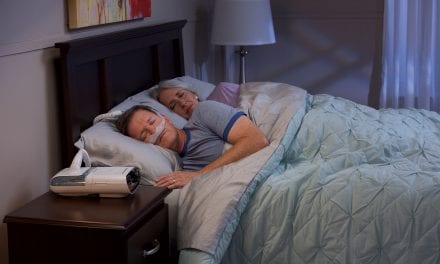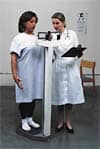In obstructive sleep apnea (OSA), dipping oxygen levels and rising carbon dioxide levels in the blood alert the sleeping brain to the problem, rousing the sleeper just long enough to re-establish breathing. While patients may have no memory of these interruptions in the morning, this cycle may repeat often throughout the night, leaving people with apnea with extreme daytime sleepiness.
In a paper published in the journal Nature Communications, researchers at Beth Israel Deaconess Medical Center (BIDMC) demonstrated that the neurotransmitter serotonin plays a critical role in rousing the brain from sleep when CO2 levels rise. Building on previous work that identified the specific neural circuitry at work in brains of mice in simulated apnea conditions, the new findings could lead to potential new drug therapies to help patients with obstructive sleep apnea get more rest.
[RELATED: Serotonin May Provide Clues to Seizure-Related Apneas]
“Our goal is to use this information to design drugs which could potentially allow a patient with sleep apnea to keep the airways open while avoiding the arousals from sleep that result in sleep fragmentation, cognitive impairment and metabolic and cardiovascular disease,” says senior author Clifford B. Saper, MD, Chair of the Department of Neurology at BIDMC, in a release.
In previous findings, Saper and colleagues traced one carbon dioxide sensing circuit to a subgroup of neurons in the parabrachial nucleus in the lower part of the brain. In a 2017 publication, Saper and colleagues showed that the parabrachial neurons alert the forebrain to rising CO2 levels and wake the sleeping brain up.
Meanwhile, other findings suggested that the neurotransmitter serotonin also plays a key role in detecting rising levels of CO2. To reconcile these findings, Saper and colleagues sought to identify the specific neurons on which serotonin acts as a CO2 sensor. Using genetically engineered mouse models, the team demonstrated that serotonin interacts with the parabrachial neurons to wake the brain up in the presence of high CO2 levels.
However, Saper’s group also showed that the nerve cells in the parabrachial nucleus that wake the sleeping brain up and those that restart the breathing are separate groups of cells, operating with a different set of neurotransmitters and receptors. That opens the door to the possibility of designing a drug targeted to allow the brain to rouse enough to restart breathing while not interrupting sleep.
“Many people cannot tolerate wearing a CPAP, so much of sleep apnea goes untreated,” Saper says. “Providing the first effective pharmacological treatment for obstructive sleep apnea—finding a way to treat this with a pill, rather than a mask all night—would be very important.”
Co-authors included Satvinder Kaur, Roberto De Luca, Mudasir A Khanday, Sathyajit S Bandaru, Renner C Thomas, Rebecca Y Broadhurst, Anne Venner, William D Todd, Patrick M Fuller and Elda Arrigoni, all of BIDMC.
This work was supported by a Program Project Grant to Saper’s lab from the National Heart Lung and Blood Institute, and by USPHS grants 2P01 HL095491, NS085477, NS112175 and NS073613.





